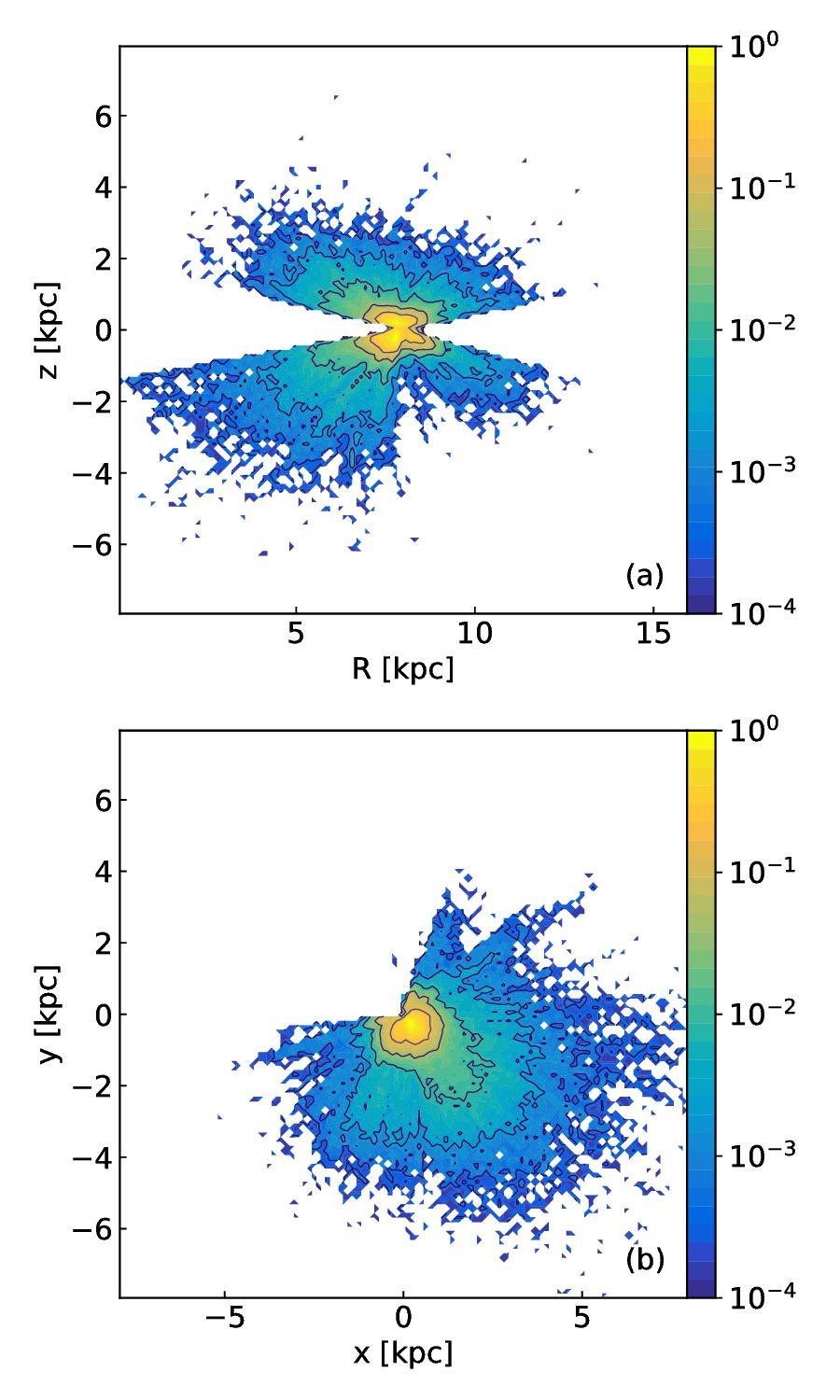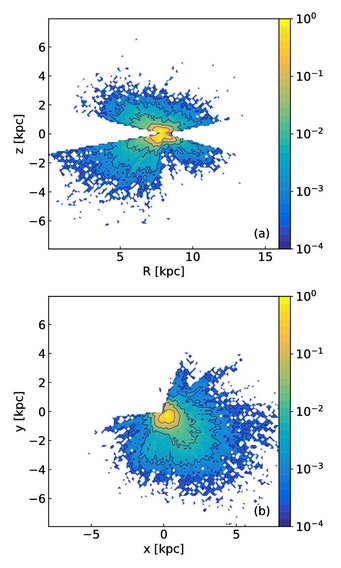Astronomers map the "chemical DNA" of over 340,000 stars to search for their long-lost siblings

The upper plot is showing the Galacto-centric radius (R) and height above the Galactic plane (z) with the Sun at (8,0).
The lower panel shows the distance from the Sun (0,0) as a phase-on view in Galactic coordinates (x,y), where the Galactic Centre is at x=8.
Modern spectroscopy disperses stellar light not only in all the different wavelengths which we know from the colours of the rainbow. Moreover, due to the high-resolution, such spectra also uncover a wealth of dark absorption lines coming from characteristic chemical elements and molecules in the stellar atmospheres. Therefore, the absorption lines are fingerprints of the stars´ unique chemical compositions as imprinted at their birth and preserved over cosmic time.
If measured precisely for very large samples of stars, astronomers can piece together the puzzle of the formation history of our Galaxy, from the very early Universe to the present day. In particular, the GALAH survey endeavours to determine the birth locations of stars in the Milky Way by high-precision multi-dimensional chemical tagging; an ambitious goal that will crucially benefit from the knowledge of present-day stellar positions and motions, soon to be delivered by the Gaia space mission.
To acquire spectra in the required very large numbers, GALAH uses the multiplexing capability (360 stars observed simultaneously) of the HERMES spectrograph, on Australia's largest optical telescope, the 3.9m AAT. HERMES was designed by the Australian Astronomical Observatory specifically with a detailed Milky-Way inventory in mind, with four non-contiguous wavelength bands that maximise the number of observable chemical species. The survey has since late 2013 been awarded more than 300 nights in a competitive manner and observations are continuing.
![Density distribution of the element abundances included in GALAH Data Release 2 over the iron abundance [Fe/H]. Among these 22 elements, most abundance trends are rather unique. Researchers can use these distinct patterns to trace back the Galactic chemical evolution history and stars that share the same chemical composition. The latter is a strong indicator that these stars were born together and are stellar siblings.](/5301888/original-1595425908.jpg?t=eyJ3aWR0aCI6OTY2LCJvYmpfaWQiOjUzMDE4ODh9--5f2cfd44e5a52d40389eb61fb4d9968822e4b57e)
The translation between the strengths of stellar absorption features and chemical abundances is complex and accurate results call for sophisticated non-equilibrium radiative transfer calculations of stellar atmospheres - a speciality of the MPIA research group "Stellar Physics and the Evolution of Chemical Elements", in particular of the GALAH members Lind (group leader), Amarsi (postdoc), and Gao (PhD student). Armed with state-of-the-art spectrum analysis techniques, the analysis team, with Buder in front, first carefully scrutinized thousands of spectra individually, and deduced their chemical compositions. The information for these few thousand representative spectra was then propagated to the full sample of 340,000 stars using an efficient data-driven code called The Cannon, also developed in-house (former postdoc Ness).
Further information
Major press release from the Australian Astronomical Observatory:
https://www.aao.gov.au/news-media/media-releases/340000-stars'-dna-interrogated-search-sun's-lost-siblings
Related Paper: Buder et al. (2018a)
The GALAH Survey: Second Data Release
https://arxiv.org/abs/1804.06041(Further papers are listet in the major press release)
Link to the MPIA group website:
http://www.mpia.de/gc-stellar-physics

![Density distribution of the element abundances included in GALAH Data Release 2 over the iron abundance [Fe/H]. Among these 22 elements, most abundance trends are rather unique. Researchers can use these distinct patterns to trace back the Galactic chemical evolution history and stars that share the same chemical composition. The latter is a strong indicator that these stars were born together and are stellar siblings. Density distribution of the element abundances included in GALAH Data Release 2 over the iron abundance [Fe/H]. Among these 22 elements, most abundance trends are rather unique. Researchers can use these distinct patterns to trace back the Galactic chemical evolution history and stars that share the same chemical composition. The latter is a strong indicator that these stars were born together and are stellar siblings.](/5301888/original-1595425908.jpg?t=eyJ3aWR0aCI6MzQxLCJmaWxlX2V4dGVuc2lvbiI6ImpwZyIsIm9ial9pZCI6NTMwMTg4OH0%3D--9e214a50bddce4c4b62c1635f32de9815cce03e2)